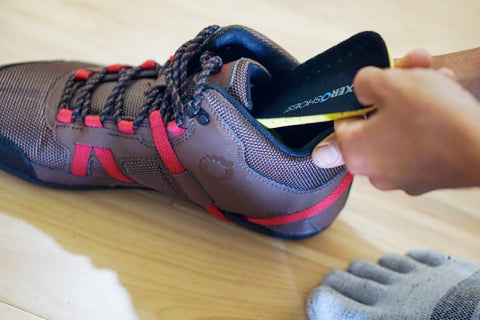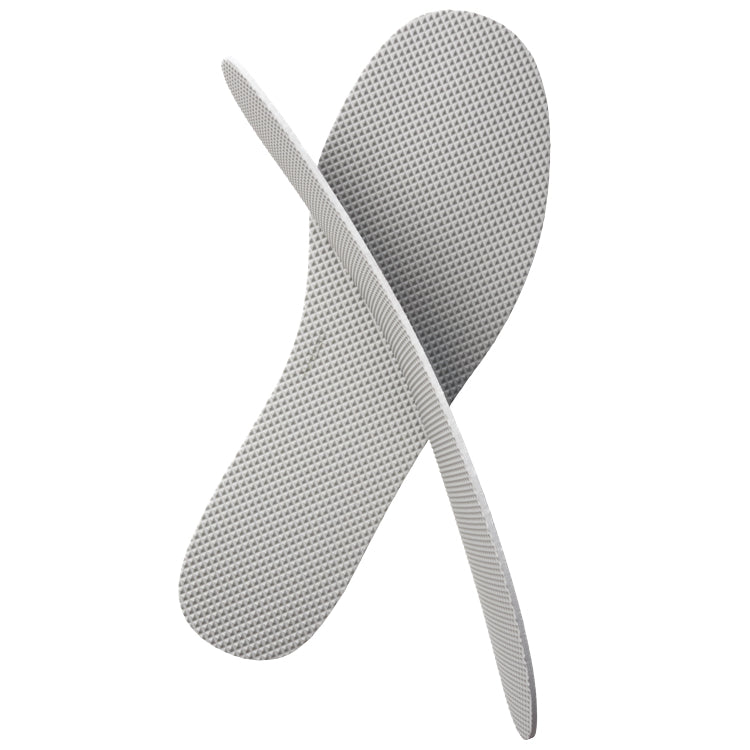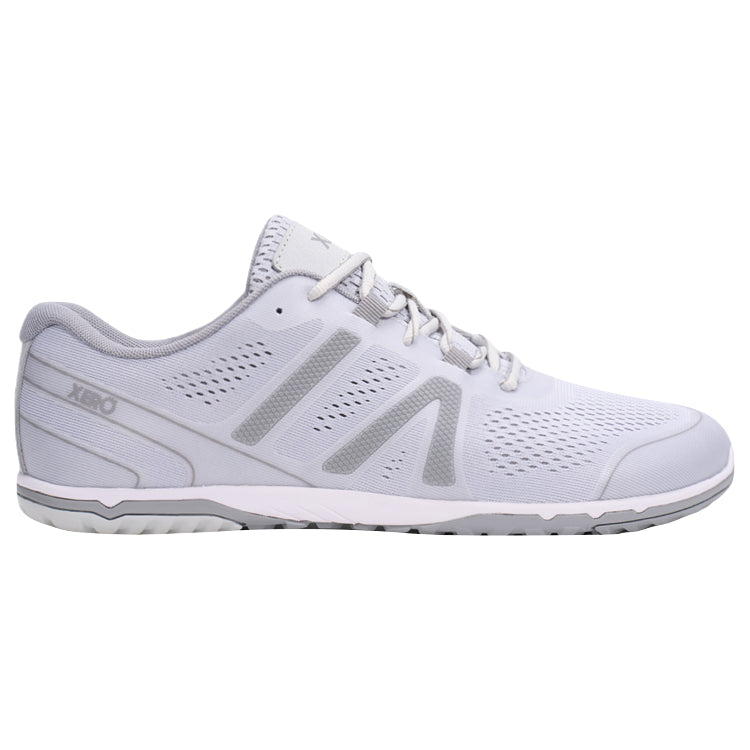
Most people never consider removing their shoe liner or insole, assuming that it’s a necessary inclusion in footwear, but we’ve found this to be an excellent way to enhance the fit and feel of almost any shoe. Removing the liner provides additional space to allow your toes to spread out naturally and—with the reduced stack height that comes with removing the liner—allows your foot to function more like a bare foot inside your shoe (i.e., it makes the shoe more minimalist).
A more minimalist-type shoe is foot-healthy because it allows you to better sense and feel the ground or the surface that you’re walking upon. This ensures that your footfalls are more conscientious, which is helpful both in terms of avoiding errant footfalls and associated injuries as well as encouraging a smoother, lower-impact gait (good for the joints and overall musculoskeletal system). A reduced shoe stack height and more minimalist-type sole also help strengthen your foot with every step. A strong foot is a more resilient foot, capable of standing up to the physical challenges of life and resisting injury. More immediately, this technique of removing your shoe liner can also improve shoe fit if you find yourself in-between sizes of footwear.
While there are many good reasons to consider removing your shoe liners, one important question remains: Will your feet hurt without the extra padding the liner provides?
There’s a common misconception that we need extra padding under our feet to walk and move about comfortably. While extra cushioning can indeed feel comfortable (as in, our body perceives it to be pillowy and impact moderating), it only serves to make our feet weak, unfavorably alter our gait, and make us more prone to sloppy, injurious footfalls. It also, in many cases, leads to even more impactful footfalls because the immediate painful repercussions of slapping the feet down during gait are blunted. Our feet were designed to bear the weight of our bodies without the help of shoes, and healthy feet can operate pain-free on a wide variety of surfaces.
If you’ve worn conventional shoes most of your life, your feet are most likely used to significant padding underneath them, and it’s possible that the removal of the liner and its layer of cushioning, however thick or thin, may feel unusual at first—mostly in the form of your feet feeling as though they’ve been through a good workout if you’ve been standing or active for a long period of time. There’s a transition period involved in the shift from conventional footwear to minimalist footwear in general, and though not as drastic, simply switching to shoes without liners can also take some time to get used to.
When you allow your foot to function more like a bare foot inside your shoe, the benefits are significant and extend throughout your entire musculoskeletal system. Removing your shoe insoles is a minor change, true, but we still do recommend using caution and listening to your body as you’re progressing through the transition phase. If removing your shoe liners causes discomfort, put your liners back in for a little while and then, at a later date, try removing them again while gradually building up wear-time in your now more-minimalist shoes.
One small change to your footwear, such as the one described above, can have a big impact on the strength and stamina of your feet! Other helpful ways to build healthy and resilient feet include using Correct Toes toe spacers and other natural footgear and performing key stretching and strengthening exercises on a daily basis.

WANT TO IMPROVE YOUR FOOT HEALTH?
Let the team at Natural Footgear help you! Subscribe to our newsletter for the latest offers and helpful info, and sign up for our FREE email courses on various topics and foot health conditions.
Sign Up →
Want to Improve Your Foot Health?
We are here to help you every step of the way. Get our newsletter for the latest offers and helpful info, and sign up for our FREE email courses on various topics and conditions, including bunions, hammertoes, neuromas, plantar fasciosis, shin splints, ingrown toenails, and more.
Sign Up →
 Most modern footwear comes with a removable liner or insole that sits in the bed of the shoe. Many people try on shoes and wear them for most of their lives without considering how the liner affects the overall fit and function of the shoe. It’s worth asking: If the liner was never meant to be removed, wouldn’t it be stitched into the shoe? Could it be that the shoe...
Read more
Most modern footwear comes with a removable liner or insole that sits in the bed of the shoe. Many people try on shoes and wear them for most of their lives without considering how the liner affects the overall fit and function of the shoe. It’s worth asking: If the liner was never meant to be removed, wouldn’t it be stitched into the shoe? Could it be that the shoe...
Read more












I just found your site and all this new info about feet and foot health, and I’m wondering if you can help me out. I’m hoping to better understand why my feet hurt after standing all day at work. What are your thoughts?
Hi, Rick. Thank you for your question and for stepping into the world of natural foot care—it’s a journey that can make a profound difference not just in how your feet feel but in your overall quality of life. Foot pain after prolonged standing is something we hear about often, and it’s a clear signal from your body that something isn’t quite aligned—literally or figuratively. The good news is that there are concrete, actionable steps you can take to better understand—and address—the root causes of your discomfort. Learning to decode your foot pain is the first step toward lasting relief and more confident, comfortable movement.
One of the primary reasons people experience foot pain after long periods of standing is due to the structure of conventional footwear. Most modern shoes feature elements like toe spring, heel elevation, rigid soles, and toe boxes that are narrower than the natural shape of the foot. These design inclusions can alter your posture and gait mechanics in subtle yet significant ways, placing unnatural stresses on your foot’s soft tissues, joints, and circulation over time. When your foot can’t splay naturally or bear weight as it was designed to, it often compensates in ways that lead to fatigue, soreness, or even more chronic issues down the line.
In addition to footwear, the surfaces you stand on throughout the day can also have a major impact. Hard, unforgiving floors—like concrete or tile—offer no give and can amplify pressure points under the foot, particularly if you’re wearing shoes that don’t allow your foot’s natural shock-absorbing structures to do their job. Add to this a lack of intrinsic foot muscle strength—something that tends to happen after years of wearing restrictive shoes—and you’ve got a recipe for end-of-day foot pain. Over time, this daily strain can contribute to the development of more persistent conditions like plantar fasciosis, ball of foot pain, or bunions.
The key to reversing this discomfort lies in gradually restoring your foot’s natural function. This involves transitioning to footwear that allows your toes to spread, your arch to load and spring, and your entire lower body to align properly. It also involves strengthening the often-overlooked muscles of the foot and lower leg through foot-specific exercises, and, in many cases, incorporating tools like Correct Toes and BlackBoard ToeBands to realign your toes and reawaken dormant foot function. None of this happens overnight, but with a bit of intention and consistency, the results can be truly life-changing.
You’re absolutely not alone in what you’re experiencing, and your question reflects an important first step: Awareness. At Natural Footgear, we’re committed to helping people reclaim their natural foot health heritage through education, community, and access to products that support healthy foot anatomy and movement. We encourage you to explore our various blogs and resources, sign up for our weekly newsletter and e-courses, reach out with follow-up questions, and most of all, listen to what your body is trying to tell you. Pain is information—and with the right tools and understanding, it can become a powerful guide toward long-term wellness.
Yours in Foot Health,
Drs. Marty & Robyn Hughes